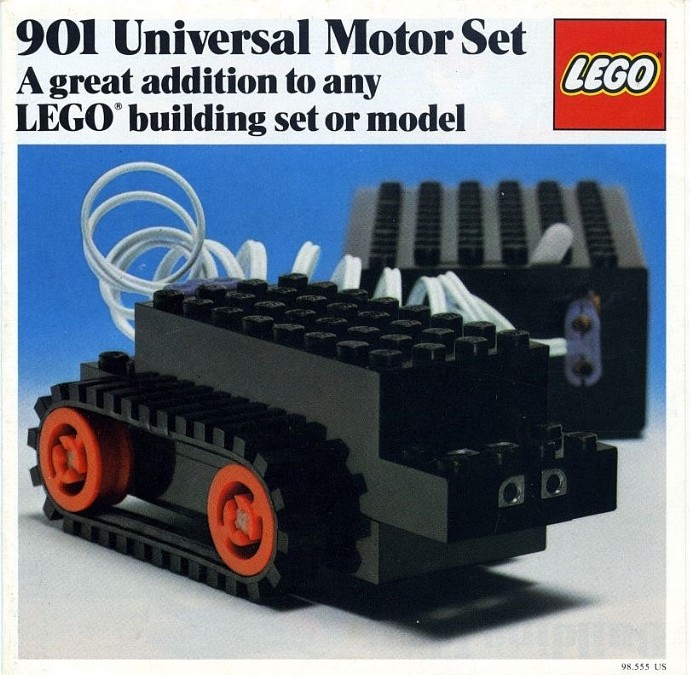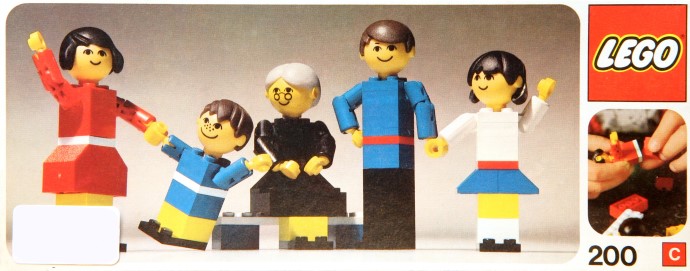Back in the olden days, when I last had any Lego (the 1970’s), it was, for the most part, just coloured bricks and plates. I think the only ‘unusual’ thing I had was a motor set. It was a block with holes for wheels, and you could either push a regular set of wheels on, a set of train wheels, or a set of bare wheels and then put caterpillar tracks on them. It attached, by way of a short, plug in lead, to a battery box that had a simple ‘back / off / forward’ lever.
It looked like this. Probably because this is a picture of the same set.
The 901 Lego Motor Set. I had one of these.
(Image, as ever, borrowed from Brickset.com)
My sister didn’t really have much Lego as I recall - she stuck to more the traditional dolls house, dolls and doll-related paraphernalia. These days she lives in the middle of Wales with a dog, some chickens and a husband but, if memory serves, a distinct lack of dolls. When we were small, however, there was one Lego set that I do remember her having, and it was the set: 200 Lego Family.
(Three guesses where this image originates)
It was a set of people - Mum, Dad, Granny and two children - that were mostly made from standard Lego bricks with the exception of articulated arms, round heads and clip on hair. The only thing I recall about them was that you could clip their hands together and dangle them in a long chain.
Presumably they weren’t a roaring success, and in the late 70’s, Lego went back to the drawing board and introduced the minifigure. They were included in any number of sets but always (1) as part of a larger set, never on their own. That changed in 2010 with the release of the Collectable Minifigs Series 1. At the time of writing, Series 10 is on the horizon.
Obviously, what with concentrating on Technic, I wasn’t going to be interested.
However, I reckoned without the subtle and wily ways of the modern retailer. As we have previously discovered, while they pretend to be helpful, jolly people who are there to make our lives easier by providing us with life’s little essentials, they are in fact out to make money!
I’ve seen several fascinating programmes on the subject of ‘How shops make you spend more money.’ which are usually put on when somebody’s gone on strike, or someone’s died and the TV schedule is thrown out of kilter and they need to pad out the evening’s broadcast by a couple of hours.
“Quick.” someone high up will say. “Dig out ‘An audience with Ken Dodd’, one of those shows with clips of animals doing daft things, and a ‘How shops make you spend more money’ documentary.”
One particular trick is to put cheap (or as the shop would have it, ‘affordable’) items very close to the checkout. These items are often aimed at children. The thinking being, people have to queue to pay, and many of these people will be accompanied by their offspring. Said young people will get bored within 0.3 seconds of having to stand in a queue, start looking around, spot the cunningly placed toy / comic / confectionery and then spend the rest of the queueing time bugging their parent to let them have the aforementioned item.
It is known, unsurprisingly, as ‘pester power’.
It is known, unsurprisingly, as ‘pester power’.
Such techniques clearly only work on children though...
So I was waiting to pay for something in a department store (another one of the ones I work for), and I happened to notice, there by the register, a box of Series 8 minifigs.
“Only £1.95,” I thought. “plus discount. I wonder what they’re like…”
Not having a parent in tow to get the puchase approved by, I arrived home with four.
My first Minifig
(Also, I would point out, this is my photo, rather than having borrowed it from Brickset!)
We are now going to take a slight detour. Bear with me.
Imagine the following scenario. My wife and I have decided (or more likely, my wife, and me just saying ‘Yes, dear.’) to buy a new sofa. So we go off to the department store (I’m fed up with typing Department Store - we both work for John Lewis) and head for the furniture department, where we are met by a nice sales assistant.
“Good morning. How can I help you?”
“Hi. We’ve decided to buy a new sofa.”
“Certainly. That’ll be £799 please. If you’d like to come over to the register.”
“Er, hang on. We haven’t told you which one we want yet.”
“Oh, you don’t get to choose. There are 16 different ones over there and we’ll just pick one out for you.”
“Umm, what?”
“You buy the sofa and we pick one out for you from that range over there.”
“But we only like one of them. Several won’t even fit in our house!”
“Well you could always try and find some other people that have bought sofas from us. Maybe one of them will have got the one you want, and you could buy it from them. Or even swap it for the one you get, if you don’t like it.”
It’s not just me, is it? That would be crazy, right? You choose what you want to buy, and then go and buy it. You don’t choose what to buy, and then hope you get lucky after you’ve paid your money. That’s not shopping - that’s a raffle!
Anyway. In 2010, Lego launched the first series of minifigs. There were 16 in the range, and they were sold in sealed packets. This meant, as you’ve probably figured out, you don’t actually know what you’re buying.
And more to the point, as far as Lego are concerned, if you want a complete set, you’re probably going to have to buy considerably more than 16.
It’s almost like they planned it...
I come across as righteously indignant, but you can hardly blame Lego - people have been doing this for years. When I was young, it was cards and stickers. Panini Football stickers were the first I remember, although not having much more than a passing interest in football (then or now), I didn’t try too hard to collect the set.
Things changed a bit in 1977 with the arrival of a certain sci-fi film. Among the millions of pieces of Star Wars merchandise was a set of trading cards. There were 66 in the set, plus 11 stickers. Each packet contained (so the internet reminds me) seven cards and one sticker. This led to lots of small boys gathering in school playgrounds going through their swap piles… ‘Got, got, got, need, got…’
And much the same thing happens today with minifigs. You can get a complete set if you buy enough, but for most people it’s easier (or more fun) to swap with fellow collectors.
Some people don’t like to leave it up to chance, or being able to find someone who wants to swap or sell that missing minifig though, which leaves you with a couple of options.
‘Feeling’, or ‘bulk buying’.
Lego release details of an upcoming set, and as soon as they do, the feelers start studying the images. Minifigs are made up of similar parts : a pair of legs, a body, a head and a base. However, they usually come with one or two accessories. A businessman might have a briefcase. A Knight might have a specifically shaped shield and so forth.
And to those with deft fingers, this is a major clue to the contents of the packet. Soon after a set is released, ‘feeler guides’ start appearing, telling people what unique parts they should be feeling for, and if there’s anything similar they need to be aware of. Otherwise you may walk away from the till, happy that you’ve got the Pirate you need to complete your set, because you felt his rapier, only to get home and find that it was in fact a fairy’s wand! So if you see someone standing by a box of figures, going though them one after another, that’s probably what they’re doing.
The other route that some people go down is to buy a complete box.
There are 16 in a set, and 60 in a box (2), so in some ways, it’s a bit of overkill, but it does guarantee that you get a set. You can’t officially buy a box, but there are plenty of ‘grey’ avenues to go down. And when people started doing this they found that contrary to expectation, distribution between figures was not equal. For any given series, there will be a couple of figures that are plentiful, most will be average in number, and one or two will be considerably harder to find.
This annoys a lot of people, who simply want to collect a set of 16. Or maybe want half a dozen of a specific figure for a scene they’re building.
But judging by the sales figures that Lego have just released, while their customers may be annoyed, they don’t seem to be annoyed enough to stop buying!
Me, I’ve just about got enough. I have a complete Series 9, I need three more to complete Series 8 and one more to complete Series 7. By the time I’ve finished, I reckon I’ll have about 30 extras, which represents about £60 that I didn’t, in theory, need to spend. Or to put it another way, that would have got me an X-Wing Fighter plus a down payment on a Tie Fighter.
I’ve got a good variety if I want to use them in stop motion videos etc, but I don’t really like the ‘blind buying’ aspect, and my fingers aren’t deft enough to let me feel with any degree of accuracy, so once I’ve tracked down those last four, I won’t be buying any more minifigs.
Somehow though, I can’t see The Lego Group losing any sleep over it.
(1) I’m a bit wary about saying ‘always’ as someone more knowledgable than me has probably just read that and thought ‘That’s not right!’. I’ll freely admit that my information comes from ‘The Lego Book’ and a few minutes on the internet.
~ ~ ~ ~ ~ ~ ~ ~ ~ ~ ~
Science-grade research this is not.
(2) The gossip says that there will be boxes of 30 in the future : one complete set plus 14 random spares.




No comments:
Post a Comment